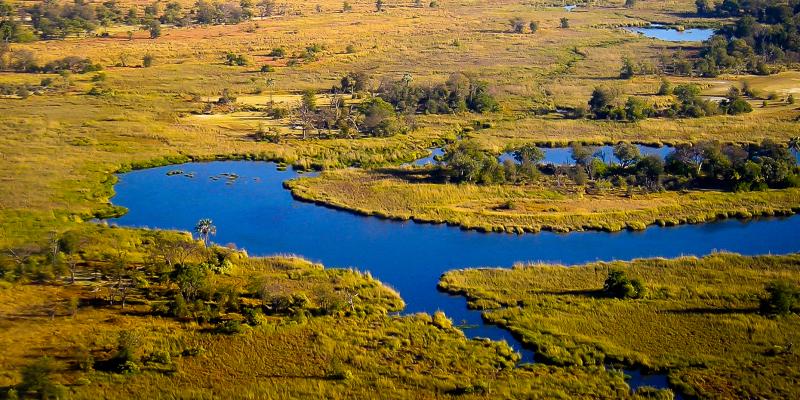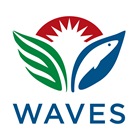
Botswana has become a leader in Natural Capital Accounting (NCA), especially when it comes to water, which is a scarce resource in the country. To find out more about Botswana’s progress in advancing water accounts and sustainable development policies, WAVES spoke with Jaap Arntzen and Tshepo Setlhogile from the Centre for Applied Research (CAR), a consulting firm in Gaborone. CAR assisted Botswana’s Department of Water Affairs in developing water accounts.
WAVES: Could you describe the context for water accounts in Botswana?
CAR: The water accounts are housed at the Department of Water Affairs (DWA). DWA and the Government opted for physical use accounts and stock accounts. The physical flow accounts are available for 2010/11 to 2014/2015, while the stock accounts are not quite complete yet. Until now, DWA had focused on the major dams, but now they are moving towards integrating groundwater as well. More than 80 percent of the rural society depends on groundwater, so it is equally important to determine how much of that water we use, and how much there is.
Monetary accounts are also important but because of data limitations they are difficult to develop, so we developed monetary indicators instead, like value -added per cubic meter of water consumed in each sector. We also looked at how much the Government gets back in terms of revenue per cubic meter used, the associated recurrent and capital expenditures, and subsidies in the water sector.
Plans also exist to extend the accounts to include gray water, and possibly subsoil water accounts for dryland farming. Some work has also been done on water use by the wildlife sector.
WAVES: What explains Botswana’s significant progress in water accounting?
CAR: There is very strong support from the Government and a long history of water accounting. When WAVES started, Botswana was one of the countries considered. There was a scoping mission involving WAVES, CAR and Econsult, and a presentation was made by Glenn Marie Lange (WAVES) to what was, at that time, the Botswana Economic Advisory Council (BEAC). The BEAC prioritized water accounts and gave DWA and CAR three months to generate policy-relevant results. And that’s exactly what happened. We presented the results with DWA, and the BEAC then agreed that more detailed accounts needed to be developed. Later on they added mineral and energy accounts.
NCA is in Botswana’s budget speech and in the State of the Nation Address, and those are formally accepted government communications. The water accounts and related policy briefs are also on the DWA website.
WAVES: Have you seen evidence of water accounting results influencing policy?
CAR: Certainly. For example, there is the annual Water Pitso, which is a consultative seminar with Botswana’s whole water sector, hosted by the Ministry of Minerals, Energy and Water Resources (MMEWR). Two years ago, a key theme at the Pitso was water accounting in Botswana, and its relevance. DWA and CAR made several presentations, including showing the water use efficiency of the different economic sectors. The results revealed that the agricultural sector is a major water consumer and yet generates very limited value-added. This finding generated lively discussions, with the Minister commenting that the agriculture sector should use existing water allocations more productively. This type of discussion between Ministries is very important for the water sector.
Botswana has a new Water Policy and Integrated Water Resources Management - Water Efficiency Plan that address the issue of water allocation between sectors. It’s a process, and water accounts are being considered in designing the water allocation system.
Water accounts have also contributed to the issue of water reuse. Where you have water treatment plants - which represent a sector in the water accounts - you must create facilities for reuse and recycling. The Government has started doing it. Gray water is an important, but underutilized resource in Botswana. It is in some cases used for irrigation. But overall people still don’t understand the importance of the resource and its potential to augment potable water supply and/or reduce demand for potable water. Also, the Government invests a lot in water treatment plants. The ones with more advanced technological treatment are more costly, but they also generate much more reusable water. If you could get that into the accounts properly, you would get an idea of the extra benefits of improved treatment technologies. From a policy perspective, it would be very important to see what is done with that water, how much value-added we generate, and how close Botswana is to the target of 96 percent reuse and recycling by 2030.
WAVES: What challenges remain to implementing NCA in Botswana and in Southern Africa more broadly?
CAR: The biggest challenge is institutionalizing NCA properly and building capacity so that it can be maintained. An additional challenge is access to data. It hasn’t been easy to develop full accounts, per the SEEA requirements. So each country is prioritizing what they want to develop.
People also need to be made aware of the water accounts - not the technical aspects, but the conclusions and the implications. They are the voters, so while a Ministry can give technical advice, in a way it’s the politicians who take the decision. The Ministry needs ammunition to make technical points, but there is also a need for end-users to understand what water accounting is. CAR would like to credit DWA: in addition to disseminating the water accounting findings to the different regional stations, they also try to reach out to communities using events like World Water Day. It’s not easy; NCA products have to be made much more palatable to all stakeholders.
The interesting thing is, there’s now a demand from the policy side, in Southern Africa and in the African Union (AU). There has to be a dual approach, developing the technical capacity, but also making sure that the link between the technical and the policymakers is established and regularly maintained. It’s a process, but Botswana has made clear progress. All of the African Ministers for water sectors have accepted an AU resolution for countries to prepare water accounts. Both the Southern African Development Community (SADC) and the AU want to adopt the SEEA model for water accounting. So it has really become, apart from a global standard, an African one as well, which is very encouraging.
WAVES: CAR recently held a Special Session on Water Accounting during the 17th WaterNet Symposium. What were your objectives for this event?
CAR: The Special Session (pictured at right) was attended by a variety of practitioners in water resource management, including from SADC, the AU, the Global Water Partnership, universities, Governments and others from Botswana, and other African countries. The main objective was to track countries' progress in compiling water accounts (Botswana, Namibia, Rwanda, and Madagascar) and to explore the policy implications of water accounts (with presentations from SADC and the AU, and a panel discussions with policy makers, including the Botswana Government). We also wanted to track new developments in the water accounting sector.
We had a similar session last year in Mauritius, where we started a Community of Practitioners (COP) on water accounting. Participants recommended that the COP be hosted by WaterNet, which is SADC’s training and capacity-building institution.
It’s very important for us that African countries start to work together more. After the Mauritius meeting, CAR kept the COP alive, in a way, but with the idea that WaterNet would become the secretariat for the COP. We are in discussions now with WaterNet about how to do this. There are also plans to develop short professional courses on water accounting, which could eventually be linked with WaterNet’s Master’s program. It’s really a Southern African grown initiative, and there’s potential to expand to other countries.
All of the presentations from the Special Session can be accessed from CAR’s website.

